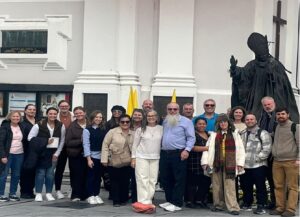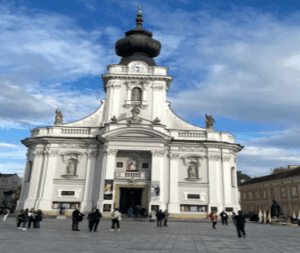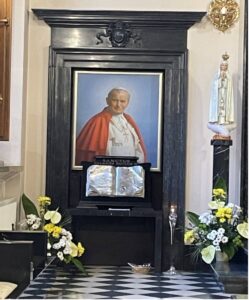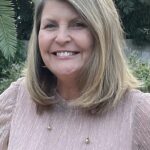
Following the Footsteps of JPII in Poland
November 12, 2025
Have you ever experienced something that’s so life-changing that it’s a struggle to even find a way to express it? Last month, I was blessed to attend a 10-day pilgrimage to Poland. To convey all that I learned on this amazing and beautiful excursion will be difficult, but I will try!

Our journey began with a Theology of the Body retreat that included 45 participants and speakers from the USA, Poland, Denmark, Ukraine, England, Lebanon, and Portugal. The retreat was hosted by the TOB Educators Group at the Divine Mercy Shrine in Krakow, which houses the cell where Jesus appeared to St. Faustina, her tomb, and the original Divine Mercy image!
The itinerary included an inspirational presentation on The Human Heart by my Ruah Woods colleague and friend, Kathleen Cory. In her remarks, she quoted TOB 51:5, “If mastery in the sphere of ethos manifests and realizes itself as ‘love, joy, peace, patience, kindness, generosity, faithfulness, gentleness, and self-mastery’… then behind each of these moral virtues, stands a specific choice that is an effort of the will, a fruit of the human spirit permeated by the spirit of God which manifests itself in choosing the good.” We were then encouraged to arm ourselves for spiritual battle by praying daily, frequenting the sacraments, and asking the Lord to heal our wounds and draw us closer to Him. It was an impactful start to our travels!

Throughout the week, we visited several locations where Pope St. John Paul II lived, prayed, and served. On John Paul II’s Feast Day (Oct. 22nd) we had the incredible opportunity to attend a private mass in the Bishop’s Residence Chapel, where the future pope (who was the Bishop of Krakow at the time) wrote his Theology of the Body. We learned that he had a small desk brought into the chapel and placed in front of the tabernacle, where he documented his prophetic “adequate anthropology” that espoused the inherent dignity of the human person created in God’s image.

Fr. David Marsden SCJ, who was traveling with our group from England, prayed for all those in ministry who promote TOB and educate others about God’s plan for each unique person and their vocation. He specifically mentioned Ruah Woods and the wonderful work that we do in educating and supporting schools, parishes and parents with our beautiful curriculum and training. We also had the unique opportunity to venerate a first-class relic of JPII: his blood!

After that lovely morning, we headed to Wadowice, the town where Karol Wojtyła grew up. We explored the beautiful Minor Basilica of the Presentation of the Blessed Virgin Mary where he was baptized as an infant on June 20, 1920. He also received his First Communion there. In a photograph of him on this day, he looks very distraught since he had just lost his mother nine days before this pivotal sacrament in his life. Providentially, his bedroom window looked out onto the church, and he disclosed that it brought him great comfort and joy to know that Jesus was so close (physically).
Furthermore, he developed an intimate relationship with the Blessed Virgin Mary as well. His father took him to the nearby Marian Shrine of Kalwaria and presented him to Mary, Mother of God, informing him, “This is your mother now.” In his childhood home, he often witnessed his father on his knees in prayer in the middle of the night. He referred to this house as his “first and foremost seminary.” The home is now a museum filled with mementos of his family, snapshots of his youth, his original journals and poetry, pictures of all of the World Youth Days that he established, and a fantastic walkway with natural soil from all of the places he visited during his pontificate! We wrapped up the celebration of his Feast Day with a pastry called, Kremowka, or “Pope’s Cake.” Every restaurant in Wadowice claims that it served the Pope his favorite dessert. It was a delicious way to end the day.

Another meaningful and poignant part of the trip was our visit to the Auschwitz concentration camp. It was there that our Catholic tour guide told us about the visit that Pope St. John Paul II made to the cell where St. Maximilian Kolbe was held captive and eventually succumbed to his death, years earlier on August 14, 1941. Here, the Pope said a prayer in thanksgiving for this courageous priest’s act of selflessness and bravery to offer himself as a sacrifice by taking the place of another prisoner condemned to starvation, who was a young husband and father. He lit a candle that remains there still. We also paused to remember in prayer all the souls that were lost here in front of the plaque that commemorates where St. Kolbe boldly stepped into his fate. The fact that so much evil happened in this place is difficult to comprehend, but a message of hope still resonated because of St. Maximilian Kolbe’s witness that human dignity and virtue can still be uplifted in the worst of conditions.

Pope St. John Paul II witnessed firsthand the degradation of the human person by communism in Poland, yet that evil helped provoke him to write the Theology of the Body. St. Maximillian Kolbe’s heroic example, along with JPII’s writings, reminds us of God’s abiding love, encouraging all of us to persevere in spreading this vital message throughout the world today. I highly recommend visiting the lovely, holy, and truly Catholic country of Poland. May Pope St. John Paul II’s legacy continue to bless our world with his ardent declaration of the inestimable value and indelible dignity of all people.
Pope St. John Paul II, pray for us!

Written by, Dena Reany,
Sales & Implementation Specialist-West
for Ruah Woods Institute
Share